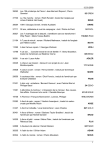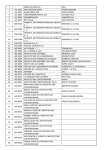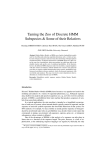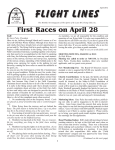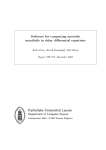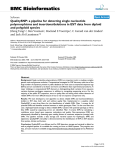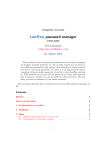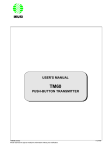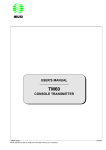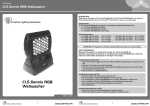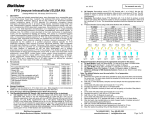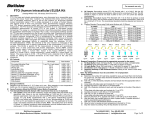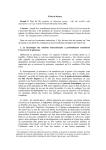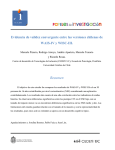Download CircuLex TM CircuLex TM
Transcript
t. uc od pr Mouse Progranulin ELISA Kit User’s Manual For Research Use Only, Not for use in diagnostic procedures ur CircuLex TM ith yo ELISA Kit for Measuring Mouse Progranulin ew CircuLex Mouse Progranulin ELISA Kit at th al an u rm se fe rt o th eu Intended Use................................................ 1 Storage......................................................... 1 Introduction.................................................. 2 Principle of the Assay.................................. 2-3 Materials Provided....................................... 3 Materials Required but not Provided........... 4 Precautions and Recommendations.............. 5 Sample Collection and Storage.................... 6 Detailed Protocol.......................................... 7-8 Calculations..................................…............ 9 Measurement Range..................................... 9 Troubleshooting............................................ 9 Reagent Stability.......................................... 9 Assay Characteristics................................... 10-12 References.................................................... 13-14 Related Products.......................................... 14 ca m Cat# CY-8108 re Intended Use ea se The CycLex Research Product CircuLex Mouse Progranulin ELISA Kit is used for the quantitative measurement of mouse progranulin in serum, plasma, cell culture supernatant, and other biological media. Pl This assay kit is for research use only and not for use in diagnostic or therapeutic procedures. nl y! Storage er en ce Pu rp os eO • Upon receipt store all components at 4°C. • Don’t expose reagents to excessive light. Fo rR ef Cat#: CY-8108 1 Version#: 151113 t. uc od pr Mouse Progranulin ELISA Kit User’s Manual For Research Use Only, Not for use in diagnostic procedures yo ur CircuLex TM ith Introduction eu se rm an u al th at ca m ew Progranulin (PGRN) also called granulin/epithelin, proepithelin, prostate cancer cell-derived growth factor, acrogranin, or paragranulin, is a cysteine-rich protein that is typically secreted in a highly glycosylated 88kDa form (1, 2). PGRN is a growth factor involved in the regulation of multiple processes including cell proliferation, tumorigenesis, wound healing, development and inflammation. PGRN is widely expressed in epithelia, bone marrow, immune cells, solid organs, and the nervous system both during development and in adulthood (3-7). In 2006, mutations in PGRN were discovered to be a cause of frontotemporal lobar degeneration (FTLD) with ubiquitinated TDP-43-positive inclusions (6, 8-10, 12, 13). More than 70 mutations in PGRN, almost all of which result in null alleles, have been identified in FTLD patients. A few causative missense mutations also result in reduced levels of PGRN (10). PGRN can be found in adipose tissue, epithelial tissue, gastrointestinal tract, reproductive organs, and so forth (11). Previous studies have demonstrated that increased gene expression of PGRN stimulates cancer cell division, invasion, and against anoikis, promoting tumor formation (2). It has been shown that PGRN could restrain rheumatoid arthritis by binding directly to tumor necrosis factor receptors (TNFR) and play an anti-inflammatory role in the processes (14). In addition, it was reported that circulating PGRN levels are elevated in patients with type 2 diabetes (15). Moreover, increased plasma PGRN levels are associated with impaired glucose tolerance rather than impaired fasting glucose (16). Although type 2 diabetes is often accompanied by obesity, the respective role of elevation of circulating PGRN levels in obesity and type 2 diabetes remains to be elucidated. o th Principle of the Assay er en ce Pu rp os eO nl y! Pl ea se re fe rt The CycLex Research Product CircuLex Mouse Progranulin ELISA Kit employs the quantitative sandwich enzyme immunoassay technique. An antibody specific for mouse progranulin is pre-coated onto a microplate. Standards and samples are pipetted into the wells and the immobilized antibody binds any mouse progranulin present. After washing away any unbound substances, an HRP conjugated antibody specific for mouse progranulin is added to the wells. Following a wash to remove any unbound antibody HRP conjugate, the remaining conjugate is allowed to react with the substrate H2O2-tetramethylbenzidine. The reaction is stopped by addition of acidic solution and absorbance of the resulting yellow product is measured at 450 nm. The absorbance is proportional to the concentration of mouse progranulin. A standard curve is constructed by plotting absorbance values versus mouse progranulin concentrations of calibrators, and concentrations of unknown samples are determined using this standard curve. Fo rR ef Cat#: CY-8108 2 Version#: 151113 t. uc od pr Mouse Progranulin ELISA Kit User’s Manual For Research Use Only, Not for use in diagnostic procedures yo ur CircuLex TM ith Summary of Procedure Incubate for 1.5 hours at room temp. ca m Wash the wells ew Add 100 µL of diluted samples to the wells at Add 100 µL of HRP conjugated anti-mouse progranulin antibody th Incubate for 1.5 hours at room temp. an u al Wash the wells Add 100 µL of Substrate Reagent rm Incubate for 10-20 minutes at room temp. th eu Measure absorbance at 450 nm se Add 100 µL of Stop Solution rt o Materials Provided re fe All samples and standards should be assayed in duplicate. The following components are supplied and are sufficient for the one 96-well microplate kit. se Microplate: One microplate supplied ready to use, with 96 wells (12 strips of 8-wells) in a foil, zip-lock bag with a desiccant pack. Wells are coated with anti-mouse progranulin antibody as a capture antibody. ea 10X Wash Buffer: One bottle containing 100 mL of 10X buffer containing Tween®-20 nl y! Pl Dilution Buffer: One bottle containing 50 mL of 1X buffer; use for standard and sample dilution. Ready to use. eO Mouse Progranulin Standard: One vial containing 120 ng of lyophilized recombinant mouse progranulin. Pu rp os HRP conjugated Detection Antibody: One bottle containing 12 mL of HRP (horseradish peroxidase) conjugated anti-mouse progranulin antibody. Ready to use. Substrate Reagent: One bottle containing 20 mL of the chromogenic substrate, tetra-methylbenzidine (TMB). Ready to use. er en ce Stop Solution: One bottle containing 20 mL of 1 N H2SO4. Ready to use. Fo rR ef Cat#: CY-8108 3 Version#: 151113 t. uc od pr Mouse Progranulin ELISA Kit User’s Manual For Research Use Only, Not for use in diagnostic procedures yo ur CircuLex TM ew • Pipettors: 2-20 µL, 20-200 µL and 200-1000 µL precision pipettors with disposable tips ith Materials Required but not Provided • Precision repeating pipettor ca m • Orbital microplate shaker at • Microcentrifuge and tubes for sample preparation th • Vortex mixer al • (Optional) Microplate washer: Manual washing is possible but not preferable. rm an u • Plate reader: capable of measuring absorbance in 96-well plates at dual wavelengths of 450/540 nm. Dual wavelengths of 450/550 or 450/595 nm can also be used. The plate can also be read at a single wavelength of 450 nm, which will give a somewhat higher reading. se • (Optional) Software package facilitating data generation and analysis eu • 500 or 1000 mL graduated cylinder th • Reagent reservoirs o • Deionized water of the highest quality er en ce Pu rp os eO nl y! Pl ea se re fe rt • Disposable paper towels Fo rR ef Cat#: CY-8108 4 Version#: 151113 t. uc od pr Mouse Progranulin ELISA Kit User’s Manual For Research Use Only, Not for use in diagnostic procedures yo ur CircuLex TM ith Precautions and Recommendations ew • Allow all the components to come to room temperature before use. m • All microplate strips that are not immediately required should be returned to the zip-lock pouch, which must be carefully resealed to avoid moisture absorption. ca • Do not use kit components beyond the indicated kit expiration date. at • Use only the microtiter wells provided with the kit. al th • Rinse all detergent residues from glassware. an u • Use deionized water of the highest quality. rm • Do not mix reagents from different kits. se • The buffers and reagents used in this kit contain NaN3 as preservatives. Care should be taken to avoid direct contact with these reagents. eu • Do not mouth pipette or ingest any of the reagents. th • Do not smoke, eat, or drink when performing the assay or in areas where samples or reagents are handled. rt o • Dispose of tetra-methylbenzidine (TMB) containing solutions in compliance with local regulations. re fe • Avoid contact with the acidic Stop Solution and Substrate Solution, which contains hydrogen peroxide. ea se • Wear gloves and eye protection when handling immunodiagnostic materials and samples of mouse origin, and these reagents. In case of contact with the Stop Solution and the Substrate Solution, wash skin thoroughly with water and seek medical attention, when necessary. Pl • Biological samples may be contaminated with infectious agents. Do not ingest, expose to open wounds or breathe aerosols. Wear protective gloves and dispose of biological samples properly. er en ce Pu rp os eO nl y! • CAUTION: Sulfuric Acid is a strong acid. Wear disposable gloves and eye protection when handling Stop Solution. Fo rR ef Cat#: CY-8108 5 Version#: 151113 t. uc od pr Mouse Progranulin ELISA Kit User’s Manual For Research Use Only, Not for use in diagnostic procedures yo ur CircuLex TM ith Sample Collection and Storage m ew Serum: Use a serum separator tube and allow samples to clot for 60 ± 30 minutes. Centrifuge the samples at 4°C for 10 minutes at 1,000 x g. Remove serum and assay immediately or store samples on ice for up to 6 hours before assaying. Aliquots of serum may also be stored at below -70°C for extended periods of time. Avoid repeated freeze-thaw cycles. an u Note: Citrate plasma has not been validated for use in this assay. al th at ca Plasma: Collect plasma using EDTA-Na2 as the anticoagulant. If possible, collect the plasma into a mixture of EDTA-Na2 and Futhan (FUT175) to stabilize the sample against spontaneous in vitro complement activation. Immediately centrifuge samples at 4°C for 15 minutes at 1,000 x g. Assay immediately or store samples on ice for up to 6 hours before assaying. Aliquots of plasma may also be stored at below -70°C for extended periods of time. Avoid repeated freeze-thaw cycles. rm Cell culture supernatant: Remove any particulates by centrifugation and assay immediately or aliquot and store samples at below -70°C. Avoid repeated freeze-thaw cycles. eu se Other biological samples: Remove any particulates by centrifugation and assay immediately or aliquot and store samples at below -70°C. Avoid repeated freeze-thaw cycles. er en ce Pu rp os eO nl y! Pl ea se re fe rt o th NOTE: THE ABOVE PROCEDURES ARE INTENDED ONLY AS A GUIDELINE. THE OPTIMAL EXPERIMENTAL CONDITIONS WILL VARY DEPENDING ON THE PARAMETERS BEING INVESTIGATED, AND MUST BE DETERMINED BY THE INDIVIDUAL USER. NO WARRANTY OR GUARANTEE OF PERFORMANCE USING THESE PROCEDURES IS MADE OR IMPLIED. Fo rR ef Cat#: CY-8108 6 Version#: 151113 t. uc od pr Mouse Progranulin ELISA Kit User’s Manual For Research Use Only, Not for use in diagnostic procedures yo ur CircuLex TM ith Detailed Protocol ca m ew The CycLex Research Product CircuLex Mouse Progranulin ELISA Kit is provided with removable strips of wells so the assay can be carried out on separate occasions using only the number of strips required for the particular determination. Since experimental conditions may vary, an aliquot of the Mouse Progranulin Standard within the kit should be included in each assay as a calibrator. Disposable pipette tips and reagent troughs should be used for all liquid transfers to avoid cross-contamination of reagents or samples. at Preparation of Working Solutions al th All reagents need to be brought to room temperature prior to the assay. Assay reagents are supplied ready-to-use, with the exception of 10X Wash Buffer and Mouse Progranulin Standard. rm an u 1. Prepare a working solution of Wash Buffer by adding 100 mL of the 10X Wash Buffer to 900 mL of deionized (distilled) water (ddH2O). Mix well. Store at 4°C for two weeks or -20°C for long-term storage. eu se 2. Reconstitute Mouse Progranulin Standard with 0.5 mL of ddH2O. After dissolved by gently mixing, immediately dispense in small aliquots (e.g. 100 µL) to micro-centrifuge tubes and store at below -70°C to avoid repeated freezing and thawing. The concentration of the mouse progranulin in vial should be 240 ng/mL, which is referred as a Master Standard of mouse progranulin. nl y! Pl ea se re Volume of Standard 60 µL of Master Standard (240 ng/mL) 300 µL of Std. 1 (24 ng/mL) 300 µL of Std. 2 (12 ng/mL) 300 µL of Std. 3 (6 ng/mL) 300 µL of Std. 4 (3 ng /mL) 300 µL of Std. 5 (1.5 ng /mL) 300 µL of Std. 6 (0.75 ng /mL) - Dilution Buffer 540 µL 300 µL 300 µL 300 µL 300 µL 300 µL 300 µL 300 µL Concentration 24 ng/mL 12 ng/mL 6 ng/mL 3 ng /mL 1.5 ng /mL 0.75 ng /mL 0.375 ng /mL 0 ng /mL eO Std.1 Std.2 Std.3 Std.4 Std.5 Std.6 Std.7 Blank fe rt o th Prepare Standard Solutions as follows: Use the Master Standard to produce a dilution series (below). Mix each tube thoroughly before the next transfer. The 24 ng/mL standard (Std.1) serves as the highest standard. The Dilution Buffer serves as the zero standard (Blank). Pu rp os Note: Do not use a Repeating pipette. Change tips for every dilution. Unused portions of Master Standard should be aliquoted and stored at below -70°C immediately. Avoid multiple freeze and thaw cycles. Sample Preparation er en ce Dilute samples with Dilution Buffer. • Serum and plasma samples may require 500- to 1,000-fold dilution. • Cell culture supernatant and other biological media require neat to appropriate dilution. Fo rR ef Cat#: CY-8108 7 Version#: 151113 t. uc od pr Mouse Progranulin ELISA Kit User’s Manual For Research Use Only, Not for use in diagnostic procedures yo ur CircuLex TM Standard Assay Procedure for Mouse Progranulin ew ith 1. Remove the appropriate number of microtiter wells from the foil pouch and place them into the well holder. Return any unused wells to the foil pouch, refold, seal with tape and store at 4°C. m 2. Dilute samples with Dilution Buffer. (See “Sample Dilution” above.) at ca 3. Pipette 100 µL of Standard Solutions (Std1-Std7, Blank) and diluted samples in duplicates, into the appropriate wells. th 4. Incubate the plate at room temperature (ca.25°C) for 1.5 hours, shaking at ca. 300 rpm on an orbital microplate shaker. an u al 5. Wash 4-times by filling each well with Wash Buffer (350 µL) using a squirt bottle, multi-channel pipette, manifold dispenser or microplate washer. rm 6. Add 100 µL of HRP conjugated Detection Antibody into each well. se 7. Incubate the plate at room temperature (ca.25°C) for 1.5 hours, shaking at ca. 300 rpm on an orbital microplate shaker. th eu 8. Wash 4-times by filling each well with Wash Buffer (350 µL) using a squirt bottle, multi-channel pipette, manifold dispenser or microplate washer. fe rt o 9. Add 100 µL of Substrate Reagent. Avoid exposing the microtiter plate to direct sunlight. Covering the plate with e.g. aluminum foil is recommended. Return Substrate Reagent to 4°C immediately after the necessary volume is removed se re 10. Incubate the plate at room temperature (ca.25°C) for 10-20 minutes, shaking at ca. 300 rpm on an orbital microplate shaker. The incubation time may be extended up to 30 minutes if the reaction temperature is below 20°C. Pl ea 11. Add 100 µL of Stop Solution to each well in the same order as the previously added Substrate Reagent. eO nl y! 12. Measure absorbance in each well using a spectrophotometric microplate reader at dual wavelengths of 450/540 nm. Dual wavelengths of 450/550 or 450/595 nm can also be used. Read the microplate at 450 nm if only a single wavelength can be used. Wells must be read within 30 minutes of adding the Stop Solution. er en ce Pu rp os Note-1: Complete removal of liquid at each step is essential to good performance. After the last wash, remove any remaining Wash Buffer by aspirating or decanting. Invert the plate and blot it against clean paper towels. Note-2: Reliable standard curves are obtained when either O.D. values do not exceed 0.25 units for the blank (zero concentration), or 3.0 units for the highest standard concentration. The plate should be monitored at 5-minute intervals for approximately 30 minutes. Note-3: If the microplate reader is not capable of reading absorbance greater than the absorbance of the highest standard, perform a second reading at 405 nm. A new standard curve, constructed using the values measured at 405 nm, is used to determine mouse progranulin concentration of off-scale samples. The readings at 405 nm should not replace the on-scale readings at 450 nm. Fo rR ef Cat#: CY-8108 8 Version#: 151113 t. uc od pr Mouse Progranulin ELISA Kit User’s Manual For Research Use Only, Not for use in diagnostic procedures yo ur CircuLex TM ith Calculations at ca m ew Average the duplicate readings for each standard, control, and sample and subtract the average zero standard optical density. Plot the optical density for the standards versus the concentration of the standards and draw the best curve. The data can be linearized by using log/log paper and regression analysis may be applied to the log transformation. To determine the mouse progranulin concentration of each sample, first find the absorbance value on the y-axis and extend a horizontal line to the standard curve. At the point of intersection, extend a vertical line to the x-axis and read the corresponding mouse progranulin concentration. If the samples have been diluted, the concentration read from the standard curve must be multiplied by the dilution factor. an u al th 1. The dose-response curve of this assay fits best to a sigmoidal 4-parameter logistic equation. The results of unknown samples can be calculated with any computer program having a 4-parameter logistic function. It is important to make an appropriate mathematical adjustment to accommodate for the dilution factor. eu se rm 2. Most microtiter plate readers perform automatic calculations of analyte concentration. The calibration curve is constructed by plotting the absorbance (Y) of calibrators versus log of the known concentration (X) of calibrators, using the 4-parameter function. Alternatively, the logit log function can be used to linearize the calibration curve (i.e. logit of absorbance (Y) is plotted versus log of the known concentration (X) of calibrators). th Measurement Range fe rt o The measurement range is 0.375 ng /mL to 24 ng /mL. Any sample reading higher than the highest standard should be diluted with Dilution Buffer in higher dilution and re-assayed. Dilution factors need to be taken into consideration in calculating the mouse progranulin concentration. re Troubleshooting Pl ea se 1. All samples and standards should be assayed in duplicate, using the protocol described in the Detailed Protocol. Incubation times or temperatures significantly different from those specified may give erroneous results. nl y! 2. Poor duplicates, accompanied by elevated values for wells containing no sample, indicate insufficient washing. If all instructions in the Detailed Protocol were followed accurately, such results indicate a need for washer maintenance. os eO 3. Overall low signal may indicate that desiccation of the plate has occurred between the final wash and addition of Substrate Reagent. Do not allow the plate to dry out. Add Substrate Reagent immediately after wash. Pu rp Reagent Stability er en ce All of the reagents included in the CycLex Research Product CircuLex Mouse Progranulin ELISA Kit have been tested for stability. Reagents should not be used beyond the stated expiration date. Upon receipt, kit reagents should be stored at 4°C, except the reconstituted Mouse Progranulin Standard must be stored at below -70°C. Coated assay plates should be stored in the original foil bag sealed by the zip lock and containing a desiccant pack. Fo rR ef Cat#: CY-8108 9 Version#: 151113 t. uc od pr Mouse Progranulin ELISA Kit User’s Manual For Research Use Only, Not for use in diagnostic procedures yo ur CircuLex TM ith Assay Characteristics m ew 1. Sensitivity The limit of detection (defined as such a concentration of mouse progranulin giving absorbance higher than mean absorbance of blank* plus three standard deviations of the absorbance of blank: A blank + 3SD blank) is better than 190 pg/mL of sample. ca * Dilution Buffer was pipetted into blank wells. er en ce Pu rp os eO nl y! Pl ea se re fe rt o th eu se rm an u al th at Typical Standard Curve Fo rR ef Cat#: CY-8108 10 Version#: 151113 t. uc od pr Mouse Progranulin ELISA Kit User’s Manual For Research Use Only, Not for use in diagnostic procedures ur CircuLex TM yo 2. Precision ew ith Intra-assay Precision (Precision within an assay) Three samples* of known concentration were tested sixteen times on one plate to assess intra-assay precision. m • Intra-assay (Within-Run, n=16) CV=2.0-2.7 % ca *Sample: mouse serum er en ce Pu rp os eO nl y! Pl ea se re fe rt o th eu se rm an u al th at Mouse progranulin conc. (µg/mL) Fo rR ef Cat#: CY-8108 11 Version#: 151113 t. uc od pr Mouse Progranulin ELISA Kit User’s Manual For Research Use Only, Not for use in diagnostic procedures ur CircuLex TM ith yo Inter-assay Precision (Precision between assays) Three samples* of known concentration were tested in five separate assays to assess inter-assay precision. ew • Inter-assay (Run-to-Run, n=5) CV=3.5-7.3 % *Sample: mouse serum eu se rm an u al th at ca m Mouse progranulin conc. (µg/ml) *Sample: mouse serum er en ce Pu rp os eO nl y! Pl ea se re fe rt o th 3. Linearity Three samples* were diluted with Dilution Buffer and assayed after dilution. The neat sample was set to 1. The neat sample was 500-fold diluted as stated in the Assay Procedure. Fo rR ef Cat#: CY-8108 12 Version#: 151113 t. uc od pr Mouse Progranulin ELISA Kit User’s Manual For Research Use Only, Not for use in diagnostic procedures yo ur CircuLex TM ith References ew 1. Daniels R, Daniels E, He Z, and Bateman A. Progranulin (acrogranin/PC cell-derived growth factor/granulin-epithelin precursor) is expressed in the placenta, epidermis, microvasculature, and brain during murine development. Developmental Dynamics, vol. 227, no. 4, pp. 593–599, 2003. at ca m 2. He Z and Bateman A. Progranulin (granulin-epithelin precursor, PC-cell-derived growth factor, acrogranin) mediates tissue repair and tumorigenesis. Journal of Molecular Medicine, vol. 81, no. 10, pp. 600–612, 2003. al th 3. Bhandari V., Palfree R. G., Bateman A. (1992) Isolation and sequence of the granulin precursor cDNA from human bone marrow reveals tandem cysteine-rich granulin domains. Proc. Natl. Acad. Sci. U.S.A. 89, 1715–1719 rm an u 4. Daniel R., He Z., Carmichael K. P., Halper J., Bateman A. (2000) Cellular localization of gene expression for progranulin. J. Histochem. Cytochem. 48, 999–1009 se 5. Daniel R., Daniels E., He Z., Bateman A. (2003) Progranulin (acrogranin/PC cell-derived growth factor/granulin-epithelin precursor) is expressed in the placenta, epidermis, microvasculature, and brain during murine development. Dev. Dyn. 227, 593–599 th eu 6. Mackenzie I. R., Baker M., Pickering-Brown S., Hsiung G. Y., Lindholm C., Dwosh E., Gass J., Cannon A., Rademakers R., Hutton M., Feldman H. H. (2006) The neuropathology of frontotemporal lobar degeneration caused by mutations in the progranulin gene. Brain 129, 3081–3090 re fe rt o 7. Matsubara T., Mita A., Minami K., Hosooka T., Kitazawa S., Takahashi K., Tamori Y., Yokoi N., Watanabe M., Matsuo E., Nishimura O., Seino S. (2012) PGRN is a key adipokine mediating high fat diet-induced insulin resistance and obesity through IL-6 in adipose tissue. Cell Metab. 15, 38–50 Pl ea se 8. Baker M., Mackenzie I. R., Pickering-Brown S. M., Gass J., Rademakers R., Lindholm C., Snowden J., Adamson J., Sadovnick A. D., Rollinson S., Cannon A., Dwosh E., Neary D., Melquist S., Richardson A., Dickson D., Berger Z., Eriksen J., Robinson T., Zehr C., Dickey C. A., Crook R., McGowan E., Mann D., Boeve B., Feldman H., Hutton M. (2006) Mutations in progranulin cause tau-negative frontotemporal dementia linked to chromosome 17. Nature 442, 916–919 eO nl y! 9. Cruts M., Gijselinck I., van der Zee J., Engelborghs S., Wils H., Pirici D., Rademakers R., Vandenberghe R., Dermaut B., Martin J. J., van Duijn C., Peeters K., Sciot R., Santens P., De Pooter T., Mattheijssens M., Van den Broeck M., Cuijt I., Vennekens K., De Deyn P. P., Kumar-Singh S., Van Broeckhoven C. (2006) Null mutations in progranulin cause ubiquitin-positive frontotemporal dementia linked to chromosome 17q21. Nature 442, 920–924 Pu rp os 10. Shankaran S. S., Capell A., Hruscha A. T., Fellerer K., Neumann M., Schmid B., Haass C. (2008) Missense mutations in the progranulin gene linked to frontotemporal lobar degeneration with ubiquitin-immunoreactive inclusions reduce progranulin production and secretion. J. Biol. Chem. 283, 1744–1753 er en ce 11. Tolkatchev D, Malik S, Vinogradova A. et al. Structure dissection of human progranulin identifies well-folded granulin/ epithelin modules with unique functional activities. Protein Science, vol. 17, no. 4, pp. 711–724, 2008. Fo rR ef Cat#: CY-8108 13 Version#: 151113 t. uc od pr Mouse Progranulin ELISA Kit User’s Manual For Research Use Only, Not for use in diagnostic procedures ur CircuLex TM ith yo 12. Boss`u P, Salani F, Alberici A et al. Loss of function mutations in the progranulin gene are related to pro-inflammatory cytokine dysregulation in frontotemporal lobar degeneration patients. Journal of Neuroinflammation, vol. 8, article 65, 2011. ca m ew 13. Finch N, Baker M, Crook R. et al. Plasma progranulin levels predict progranulin mutation status in frontotemporal dementia patients and asymptomatic family members. Brain, vol. 132, no. 3, pp. 583–591, 2009. at 14. Tang W, Lu Y, Tian QY. et al. The growth factor progranulin binds to tnf receptors and is therapeutic against inflammatory arthritis in mice. Science, vol. 332, no. 6028, pp. 478–484, 2011. al th 15. Youn BS, Bang SI, Klöting N. et al. Serum progranulin concentrations may be associated with macrophage infiltration into omental adipose tissue. Diabetes, vol. 58, no. 3, pp. 627-636, 2009. rm an u 16. Tönjes A, Fasshauer M, Kratzsch J, Stumvoll M, and M. Bluher M. Adipokine pattern in subjects with impaired fasting glucose and impaired glucose tolerance in comparison to normal glucose tolerance and diabetes. PLoS One, vol. 5, no.11, Article ID e13911, 2010. eu se Related Products PRODUCED BY nl y! Pl ea se re fe rt o th * CircuLex Rat Adiponectin ELISA Kit: Cat# CY-8049 * CircuLex Human Adiponectin ELISA Kit: Cat# CY-8050 * CircuLex Mouse Adiponectin ELISA Kit: Cat# CY-8051 * CircuLex Dog Adiponectin ELISA Kit: Cat# CY-8052 * CircuLex Human TXNIP ELISA Kit: Cat# CY-8090 * CircuLex Human Progranulin ELISA Kit: Cat# CY-8101 * CircuLex Mouse Progranulin ELISA Kit: Cat# CY-8108 Pu rp os eO CycLex Co., Ltd. 1063-103 Terasawaoka Ina, Nagano 396-0002 Japan Fax: +81-265-76-7618 E-mail: [email protected] URL: http://www.cyclex.co.jp er en ce CycLex/CircuLex products are supplied for research use only. CycLex/CircuLex products and components thereof may not be resold, modified for resale, or used to manufacture commercial products without prior written approval from CycLex Co., Ltd.. To inquire about licensing for such commercial use, please contact us via email. Fo rR ef Cat#: CY-8108 14 Version#: 151113














